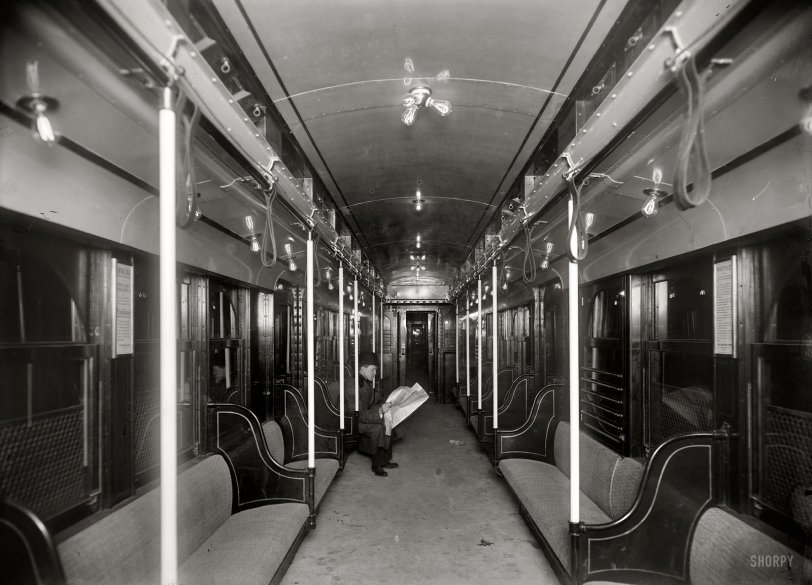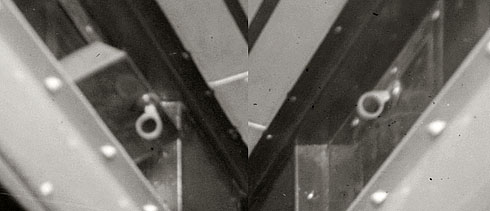


Framed or unframed, desk size to sofa size, printed by us in Arizona and Alabama since 2007. Explore now.
Shorpy is funded by you. Patreon contributors get an ad-free experience.
Learn more.

- Tough Guys
- Lost in Toyland
- And without gloves
- If I were a blindfolded time traveler
- Smoke Consumer Also Cooks
- Oh that stove!
- Possibly still there?
- What?!?
- $100 Reward
- Freeze Frame
- Texas Flyer wanted
- Just a Year Too Soon
- WWII -- Replacing men with women at the railroad crossing.
- Yes, Icing
- You kids drive me nuts!
- NOT An Easy Job
- I wonder
- Just add window boxes
- Icing Platform?
- Indiana Harbor Belt abides
- Freezing haze
- Corrections (for those who care)
- C&NW at Nelson
- Fallen Flags
- A dangerous job made worse
- Water Stop
- Passenger trains have right of way over freights?
- Coal
- Never ceases to amaze me.
- Still chuggin' (in model form)
Print Emporium
Submariner: 1908

Under the Hudson River circa 1908. "Interior of car, N.Y.-N.J. Tunnel." Today this would be the PATH train. 8x10 glass negative, G.G. Bain. View full size.
The smell of the subway
The earliest subway cars I can remember had air plane like seating, two on the left, and two on the right, all the seats were rattan, (bamboo splints), and I just wanted to be tall enough to reach one of the many 'commuter straps', actual leather straps that hung from the ceiling, far above the chrome pole that I clung to with my grandma!
Screwed
Regarding the statement "High Class Passengers", chances are the bulbs would still be in their sockets and not in someones home because the bulbs made for the transit system screwed in the opposite direction of standard bulbs so that you were not able to use them out of the transit system.
Flashed on the Train
Flash back then wasn't anything like what we now know as flash. It might have even been flash powder(magnesium) in a tray. Light output was not the instant blip we're so familiar with today.
Hard-wearing seats
Those seats were made from "transit weave" rattan. They weren't made with sundresses in mind, but rather grubby workmen in dirty clothes. Almost impossible to stain (provided they kept applying the linseed oil or varnish) and very durable.
Chicago had cars with this material as late as the early 1960s.
Horrors of Days Gone By
This photo brought back memories of being a little girl of about 7 and riding the train to Coney Island. Those seats you see were made of woven bamboo or something. Sitting on them for hours (while wearing a sundress) in the blazing summer heat was not only sweaty and prickly, but one disembarked with a basketweave behind. Funny the things that stay in your mind from childhood.
Clerestory vents
The fittings shown enable car workers (using a window pole) to open and close the hinged vent windows on the clerestory running along the roofline of the car. A very common feature on all passenger cars (subway, elevated and regular rail) until about the 1930s.
Two Styles of Bulb
Note the single-hairpin-loop Edison/Mazda bulbs as well as the smaller and slightly earlier style Edison bulb
that can be seen nearer the center of the car.
http://electriclights.tripod.com/bulbsantique1.htm
I have four working Mazdas from 1907; I use them, two each, in my bath & kitchen. They shine a pleasant shade of amber
without any globe over the bulb that never blinds one's eyes.
Where's Ollie?
Interesting to see Stan Laurel reading a paper on the train, huh?
High class passengers only
I wonder how many seconds those light bulbs would last on today's subway.
Nature's breezes
As there are interior bars and exterior grills on the windows, I suspect that these might've been raised during warmer times of the year, giving passengers some semblence of relief, in the era before widespread use of deodorant.
Until the mid-1950s, NY's BMT line ran very old open vestibule cars whose windows were fully opened in the summer months. 1/2 inch horizontal bars kept passengers from leaning out the open windows.
The car in the photo appears to have been configured to hold advertising signs. Just like later generation subway cars, the signs would be held in place on the curved portion of the top of the side walls just above the windows. So maybe they were removed for the photo shoot?
[This was a brand-new car. The picture was taken in 1908, the year the tunnel under the river was finished.- Dave]
If Only
Ahh, if only this were the train I took from Newark to school in NYC.
The Hudson Tubes
This car was operated by the Hudson and Manhattan Railroad in what were commonly called the Hudson Tubes. The line was taken over by the Port Authority Trans-Hudson Corporation (PATH) on September 1, 1962. The takeover was closely intertwined with the construction of the World Trade Center.
See http://www.hudsoncity.net/tubesenglish/3-operatinghistory.html
The "black cars" like the one in the photo remained in service for close to half a century. I rode in them many times between Jersey City and Manhattan during the 1940s and 50s. By then, as you would expect, the cars were old and dingy. The only touch of modernization was the installation of newer light bulbs. The seats were very hard and uncomfortable, the cars noisy and hot in the summer since they obviously were not air conditioned. The introduction of the "K" cars in the late 1950s and early 60s was a huge improvement.
Great detail
What do you think is the purpose of the finger pulls along the top on both sides?
[Maybe ventilation. Some of them are open, like the one on the left below. - Dave]

Not too crowded
Is that Stan Laurel in his younger days reading the paper?
Interesting
A little surprised to see a "smoking prohibited" sign back in a time when smoking really wasn't an issue. Maybe it's for safety reasons.
Nice
That's a really nice looking car and I bet it doesn't smell like urine. Since it's 1908, I'm guessing this was taken when the car was stationary or we'd see blurring.
[Or maybe not. This photo was taken with a flash. - Dave]
Sweet!
No graffiti or advertisment in sight, sweet it was!
Beautiful!
The dividers between the seats add so much visual interest -- wish we still had them. The light bulbs are fantastic! Wonder when the first overhead fans were installed? In the dog days of summer, these early cars must have felt like rolling kilns.
























On Shorpy:
Today’s Top 5